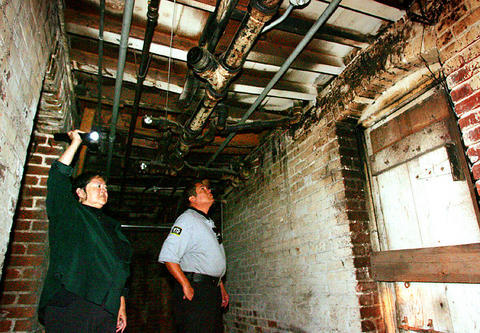Tunnels run beneath Chinatown: brick-walled passages that were once home to people and activities that could not be mentioned aboveground.
Rick Lew knows, because he walked the passages as a child, entering through a trapdoor in his grandfather's liquor store.
"There was a nightlife you couldn't see from the streets," he said.

PHOTO: AP
But to many others, the lace-work of tunnels sprawling under the city was just another tall tale from Fresno's days as a Western railroad town and a hub of gambling and prostitution.
Now, a group of archeologists is using ground-penetrating radar to find evidence of the secret passages, which are believed to branch out from long-abandoned basements littered with cobwebs and filth.
The project, funded by the city and headed by a group working to preserve Chinatown, will take data gathered via radar and compare the findings to the memories of those who recall the neighborhood's heyday, said Kathy Omachi, vice president of Chinatown Revitalization. That will help archeologists decide where to dig trenches and look for the passages, researchers said.
The approximately six blocks just west of the railroad tracks that make up the historic Chinatown were Fresno's birthplace, said Karana Hattersley-Drayton, the city's historic preservation officer. Unlike the better-known Chinese enclaves of San Francisco and New York, there's little left of it today -- at least on the surface.
But fire insurance maps from the 1880s show a densely populated area, a stark contrast from the wide-open ranch and farm country all around. It was home to the Chinese laborers who laid Fresno's foundations, and to successive layers of immigrants -- Japanese, Armenians, Mexicans, Portuguese, Basques and others -- who were kept separate from the growing white population by the iron boundary of the train tracks.
The area long housed family-run stores, temples, churches, Chinese and Japanese schools. But it was also host to illicit activities kept out of the "good side of town" -- gambling, drinking during Prohibition, and prostitution.
Omachi's father, who was from a Japanese immigrant family, was born here in 1913 "between a bar and a house of ill repute," she said.
Many establishments had basements, some of them interconnected. Of those that can still be seen today, some end in bricked-off walls that longtime residents say hide tunnel entrances.
As late as the 1950s, when Lew was a boy, Chinatown was still thriving -- both its respectable establishments and as its shadier side.
He remembers visiting the underground world with his father, passing though a dark basement before descending into a lit tunnel with an arched roof and enough space for two people to pass by each other. There were people there he recognized from the neighborhood. And then there were the glamorous women whose images remain seared in his memory.
"They were off to the side, in bright satin dresses, one red, one blue," said Lew, speculating that they were probably prostitutes. "I later asked my father about it. He said it was something we don't mention."
Jon Brady, lead archeologist on the project, said the tunnels may have been built to provide cool underground storage in a region known for sweltering summer heat. But they later proved handy for other purposes, even escape when necessary.
"These groups that lived on the fringe could have resorted to them to protect themselves, communicate away from public view, who knows what else," Brady said.
Local lore holds, though it still hasn't been proved by research, that a tunnel one time extended beyond the railroad tracks into the traditionally white part of town, possibly allowing "respectable" citizens access to the illicit charms of Chinatown.
"Some say that was blown up during Prohibition," said Hattersley-Drayton, who got a lot of calls from longtime residents once the project got started. "I'm hearing that from a lot of people, but we just don't know yet."
In the 1950s and 1960s, many of Chinatown's buildings were torn down to make way for new development or freeways, and much of the history was buried, Lew said.
"Many of the older residents packed up and left, and it started getting rough," Lew said. He now lives far from Chinatown, but remains surrounded by artifacts from the days his family was an important part of the neighborhood: tall, elaborately decorated vases, paintings and sculptures handed down by his grandfather, and the old manual cash register that rang up purchases at the liquor store.
Today, Fresno's Chinatown is largely abandoned, peopled by the homeless, with many of its facades boarded up. It's a part of the region's history that's been largely forgotten.
As downtown develops it's critical "to look at where we were," said Patti Miller, spokeswoman for the city.
Someday, Hattersley-Drayton hopes, Chinatown and its excavated tunnels might be developed for heritage tourism, bringing some income to the now-impoverished area.
"This is a first step, and it's about approaching parts of community history that are not in books," Brady said. "Parts that are literally below the surface, but that deserve to be told."

BACKLASH: The National Party quit its decades-long partnership with the Liberal Party after their election loss to center-left Labor, which won a historic third term Australia’s National Party has split from its conservative coalition partner of more than 60 years, the Liberal Party, citing policy differences over renewable energy and after a resounding loss at a national election this month. “Its time to have a break,” Nationals leader David Littleproud told reporters yesterday. The split shows the pressure on Australia’s conservative parties after Prime Minister Anthony Albanese’s center-left Labor party won a historic second term in the May 3 election, powered by a voter backlash against US President Donald Trump’s policies. Under the long-standing partnership in state and federal politics, the Liberal and National coalition had shared power

NO EXCUSES: Marcos said his administration was acting on voters’ demands, but an academic said the move was emotionally motivated after a poor midterm showing Philippine President Ferdinand Marcos Jr yesterday sought the resignation of all his Cabinet secretaries, in a move seen as an attempt to reset the political agenda and assert his authority over the second half of his single six-year term. The order came after the president’s allies failed to win a majority of Senate seats contested in the 12 polls on Monday last week, leaving Marcos facing a divided political and legislative landscape that could thwart his attempts to have an ally succeed him in 2028. “He’s talking to the people, trying to salvage whatever political capital he has left. I think it’s

Polish presidential candidates offered different visions of Poland and its relations with Ukraine in a televised debate ahead of next week’s run-off, which remains on a knife-edge. During a head-to-head debate lasting two hours, centrist Warsaw Mayor Rafal Trzaskowski, from Polish Prime Minister Donald Tusk’s governing pro-European coalition, faced the Eurosceptic historian Karol Nawrocki, backed by the right-wing populist Law and Justice party (PiS). The two candidates, who qualified for the second round after coming in the top two places in the first vote on Sunday last week, clashed over Poland’s relations with Ukraine, EU policy and the track records of their

UNSCHEDULED VISIT: ‘It’s a very bulky new neighbor, but it will soon go away,’ said Johan Helberg of the 135m container ship that run aground near his house A man in Norway awoke early on Thursday to discover a huge container ship had run aground a stone’s throw from his fjord-side house — and he had slept through the commotion. For an as-yet unknown reason, the 135m NCL Salten sailed up onto shore just meters from Johan Helberg’s house in a fjord near Trondheim in central Norway. Helberg only discovered the unexpected visitor when a panicked neighbor who had rung his doorbell repeatedly to no avail gave up and called him on the phone. “The doorbell rang at a time of day when I don’t like to open,” Helberg told television